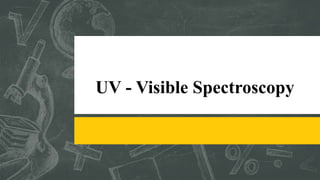
UV visible spectroscopy.pptx
- 1. UV - Visible Spectroscopy
- 2. Ultraviolet – Visible Spectroscopy UV-Visible spectroscopy deals with the study of absorption of light in the UV region (100- 400 nm) & visible region (400-800 nm) of the electromagnetic spectrum. Classification of UV-Visible spectrum :- Far UV region – 120-200 nm – Saturated organic compound (single bond) Near UV region – 200-380 nm – Quartz Visible UV region – 380-700 nm – Large no. of conjugated double bonds (β-Carotene)
- 3. UV – Visible Absorption In UV/VIS spectroscopy, the transition which result in the absorption of EM radiation in this region are transition between electronic energy levels . Hence it is also called electronic spectroscopy.
- 4. Molecular Absorption In molecules, not only have electronic level but also consist of vibrational & rotational sub-levels. This result in band spectra.
- 5. Principle of UV – Visible Spectroscopy Basically, spectroscopy is related to the interaction of light with matter. As light is absorbed by matter, the result is an increase in the energy content of the atoms or molecules. The Principle of UV-Visible Spectroscopy is based on the absorption of ultraviolet light or visible light by chemical compounds. When a molecule absorbs a photon of UV-Vis light, molecule is excited from its ground state. In other words, an electron is promoted from HOMO (Highest-energy Occupied Molecular Orbital) of the molecule to the LUMO (Lowest-energy Unoccupied Molecular Orbital) of the molecule. The HOMO is commonly a π orbital of conjugated functional group and the LUMO is commonly a π* orbital of conjugated functional group. The smaller the energy difference between HOMO & LUMO, the less energy is needed & the longer the wavelength that will be absorbed.
- 6. INSTRUMENTATION & WORKING 1. Light source 2. Monochromator 3. Sample & Reference 4. Detector
- 7. APPLICATIONS Qualitative & quantitative analysis :- Identifying the functional group Structure of chemical compound Detection of impurity Detection of isomer Determine molecular weight of sample
- 9. 1. σ → σ* transition σ electron from orbital is excited to corresponding anti-bonding orbital σ*. The energy required is large for this transition. Example :- Methane(CH4) has C-H bond only and can undergo σ → σ* transition and shows absorbance maxima at 125 nm.
- 10. 2. π → π* transition π electron in a bonding orbital is excited to corresponding anti-bonding orbital π*. Compounds containing multiple bonds like alkenes, alkynes, carbonyl, nitriles, aromatic compounds, etc undergo π → π* transition. Example :- Alkenes generally absorb in the region 170 to 250 nm.
- 11. 3. n → σ* transition Saturated compounds containing atoms with lone pair of electrons like O, N, S & halogens are capable of n → σ* transition. These transition usually requires less energy than σ → σ* transitions. The number of organic functional groups with n → σ* peaks in UV region is small (150 – 250 nm).
- 12. 4. n → π* transition An electron from non-bonding orbital is promoted to anti-bonding π* orbital. Compounds containing double bond involving hetero atoms (C=O, C≡N, N=O) undergo such transitions. n → π* transitions require minimum energy & show absorption at longer wavelength around 300 nm.
- 13. Types of Absorption Bands 1. R – Bands (Radical) :- (Ɛmax < 100) Bands due to n → π* transition in compounds with single chromatographic groups Example :- Carbonyl group, nitro group 2. K – Bands (Conjugate) :- (Ɛmax > 10,000) Bands due to π → π* transition in a compound with conjugated π system Example :- Dienes, polyene, enones & aromatic rings 3. B – Bands (Benzenoid Bands) :- (Ɛmax = 230 – 270) Bands due to π → π* transition in aromatic/hetero aromatic compounds Example :- Benzene ring compounds 4. E – Bands (Ethylenic Bands) :- (Ɛmax = 2000 – 14,000) Bands in benzenoid system of ethylenic part enclosed in cyclic conjugation E1 & E2 of benzene are observed near 180 nm & 200 nm
- 14. Types of Shifts 1. Bathochromic Shift (Red Shift) :- Absorption maxima shifts to longer wavelength Due to presence of an auxochrome or by the change of solvent Example :- CH2-CH2 max = 175 nm CH3-CH2-CH=CH2 max = 185 nm 2. Hypsochromic Shift (Blue Shift) :- Absorption maxima shifts to shorter wavelength Due to presence of group causes removal of conjugation or by change of solvent Example :- max = 245 nm
- 15. 3. Hyperchromic Shift :- Absorption intensity of a compound is increased If auxochrome introduces to the compound, the intensity of absorption increases Example :- Pyridine 2-methyl pyridine Ɛ= 257 nm Ɛ= 260 nm
- 16. 4. Hypochromic Shift :- Absorption intensity of a compound is decreased